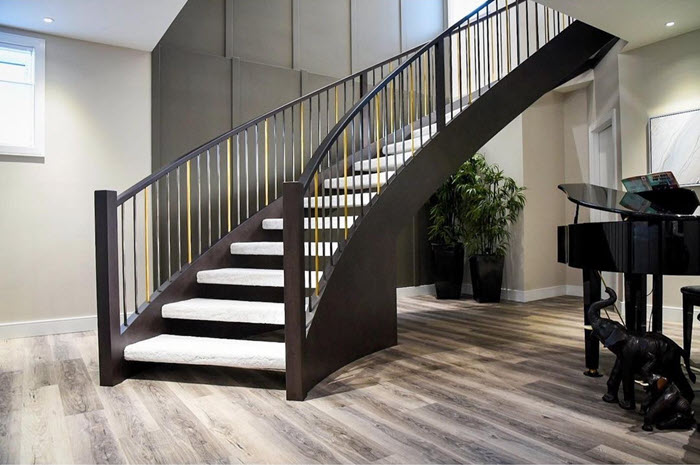Stair Railing Maintenance: Keeping Your Installation Looking Sharp in 2024

Stair railings are not only practical features in your house; they are also essential design elements that play a part in the overall look and safety of your home. Stair Railing Maintenance is essential to making them safe, long-lasting, and aesthetically pleasing in the long run. In 2024, as home design continues to change, so do the most effective ways to maintain stair railings. This ultimate guide will ensure your stair railing installation remains sharp and in top working condition all year round.
Knowing Various Materials
Various materials need different care methods. It’s important to know the usual materials used for stair railings and their individual requirements before proceeding with specific maintenance advice.
1. Wood:
- Often used due to its warm, traditional appearance.
- Needs constant cleaning, polishing, and dryness protection.
2. Metal:
- Comprises stainless steel, wrought iron, and aluminum.
- Requires rust protection, cleaning, and periodic polishing.
3. Glass:
- Provides a sleek, airy appearance.
- Needs regular cleaning to stay clear and avoid scratches.
4. Mixed Materials:
- Blends wood, metal, and glass elements.
- Each material needs to be cared for according to its own requirements.
- General Maintenance Tips
No matter what material your stair railing is made of, there are some general maintenance tips that can be applied to all stair railings. Following these tips will ensure that you preserve the integrity and appearance of your railings.
1. Periodic Cleaning:
- Dust and dirt may settle on stair railings, lowering their appearance.
- Use a microfiber duster or a soft cloth to wipe out the dust.
- Apply mild soap and water for deeper cleaning, then dry meticulously to avoid moisture damage.
2. Inspection:
- Periodically check your stair railings for signs of wear or damage.
- Check for loose screws, cracks, or rust patches.
- Fix any problems immediately to avoid further damage.
3. Protective Coatings:
- Using protective coatings can protect your railings from the elements.
- For wood, varnish or sealant to keep out moisture and UV damage.
- For metal, use anti-rust coatings or paint to avoid corrosion.
Maintenance by Material
Let’s move on to the particular maintenance requirements for various materials to keep your stair railings in pristine condition.
Wood Railings
1. Cleaning:
- Clean wooden railings with a soft cloth regularly.
- Clean with mild soap and water solution, and dry using a soft cloth.
2. Polishing:
- Restore shine and protect the surface with wood polish.
- Apply polish using a soft cloth, going with the wood grain.
3. Protection:
- Seal with a high-grade wood sealant or varnish to protect from moisture and UV exposure.
- Re-seal every 1-2 years, or as required due to wear and exposure.
4. Repair:
Repair any scratches or dents as soon as possible by sanding the spot and filling with wood filler if needed.
Refinish the spot using stain and sealer to blend with the rest of the railing.
Metal Railings
1. Cleaning:
- Clean metal railings with a damp cloth to get rid of dust and dirt.
- Use water with a mild detergent for more effective cleaning.
- Dry completely to avoid water spots and rust.
2. Polishing:
- Use metal polish to keep surfaces shiny and resistant to tarnish.
- Refer to the manufacturer’s directions for optimum results.
3. Rust Prevention:
- Regularly check for rust or any indications of rust.
- If rust does occur, scrape off the rust using a wire brush or sandpaper, followed by a rust-inhibiting primer and paint.
4. Protection:
- Apply a clear protective coating to stop rust and corrosion.
- Make sure the coating is for the particular type of metal.
- Glass Railings
1. Cleaning:
- Clean glass railings using a glass cleaner or water and vinegar solution.
- Soft cloth or sponge should be used in order not to scratch the glass.
2. Scratch Prevention:
- Do not use abrasive materials or chemicals that can scratch or harm the glass.
- Periodically check for scratches and repair them using glass repair kits when needed.
3. Structural Inspection:
- Make sure the glass panels are properly fastened and inspect for any crack or chip.
- Replace broken glass panels as soon as possible to ensure safety and appearance.
- Mixed Material Railings
1. Cleaning:
- Clean every material according to its specific maintenance needs.
- Use care in using cleaning materials to prevent harm to neighboring materials.
2. Inspection and Repair:
- Regularly inspect all the parts of the mixed material railing.
- Repair any problem with each material as soon as possible to avoid further damage.
3. Protective Measures:
- Use protective coatings appropriate for every material.
- Guarantee coating compatibility to prevent undesirable interaction between materials.
Seasonal Maintenance
Outdoor-styled stair railings need to be maintained seasonally in order to remain in top condition. The following is a guide on seasonal maintenance work:
Spring
1. Deep Cleaning:
- Clear winter dirt and debris off the outdoor railings.
- Deep clean indoor railings to get rid of dust built up during the winter months.
2. Inspection:
- Look for any winter weather damage, including rust or water damage.
- Replace or repair damaged parts as necessary.
3. Protective Coatings:
Apply protective coatings to wooden and metal railings to make them ready for summer.
Summer
1. Regular Cleaning:
- Dust and wipe railings regularly to keep them clean.
- For exterior railings, remove pollen, bird droppings, and other debris.
2. UV Protection:
- Make sure wooden railings receive proper UV protection to avoid sun damage.
- Consider using UV-resistant coatings for added protection.
3. Structural Checks:
- Ensure that all railings are securely fastened and stable.
- Check for any loose screws or brackets and tighten them.
Fall
1. Preparation for Winter:
- Clean railings thoroughly to remove leaves, dirt, and other debris.
- Apply protective coatings to wood and metal railings to shield them from winter weather.
2. Inspection:
- Check for any signs of damage or wear that need addressing before winter sets in.
- Fix any problems to avoid them from getting worse over the cold months.
- Winter
1. Snow and Ice Disposal:
- Leave outdoor railings clear of snow and ice to avoid damage.
- Gentle plastic shovel or brush to not scratch the surface.
2. Regular Inspections:
- Regularly inspect railings for any instances of rust, water damage, or other problems.
- Fix any issues straight away to avoid causing further damage.
3. In-House Upkeep:
Concentrate on upkeep of in-house railings, cleaning and polishing them.
Professional Maintenance
While routine DIY maintenance is necessary, professional maintenance can greatly prolong the life and attractiveness of your stair railings. Consider the following professional services:
1. Deep Cleaning and Polishing:
Professional cleaning services can eliminate embedded dirt and grime.
Polishing services can revive the shine and luster of your railings.
2. Repair and Restoration:
Professional repair services can deal with more extensive damage, like broken glass panels or heavily rusted metal.
Restoration services may restore older railings to their former glory.
3. Protective Coating Application:
Experts may apply superior protective coatings that are more protective and long-lasting than do-it-yourself products.
Conclusion
Stair railing upkeep is an important part of house maintenance that guarantees safety, longevity, and good looks. With the knowledge of the particular requirements of various materials and regular cleaning, checking, and protective work, you can have your stair railings looking razor-sharp in 2024 and beyond. Seasonal upkeep and professional treatments will help promote the long life and attractiveness of your railings even more, making them a timeless part of your house.
No matter if you have wooden, metal, glass, or composite material railings, by following these maintenance tips, you will be able to maintain their functionality and beauty. Adopt these habits, and your stair railings will keep on beautifying your home and ensuring safe passage for years to come.




